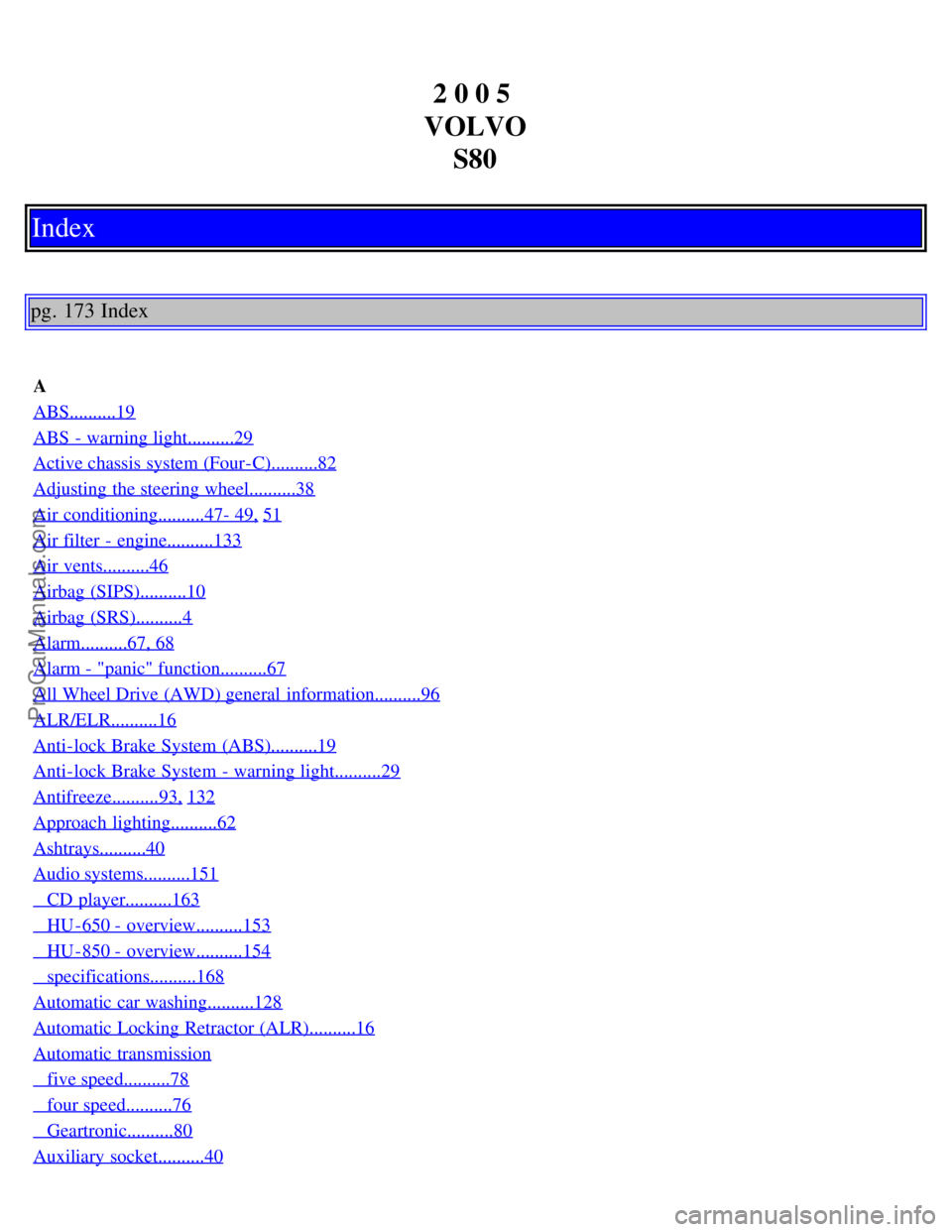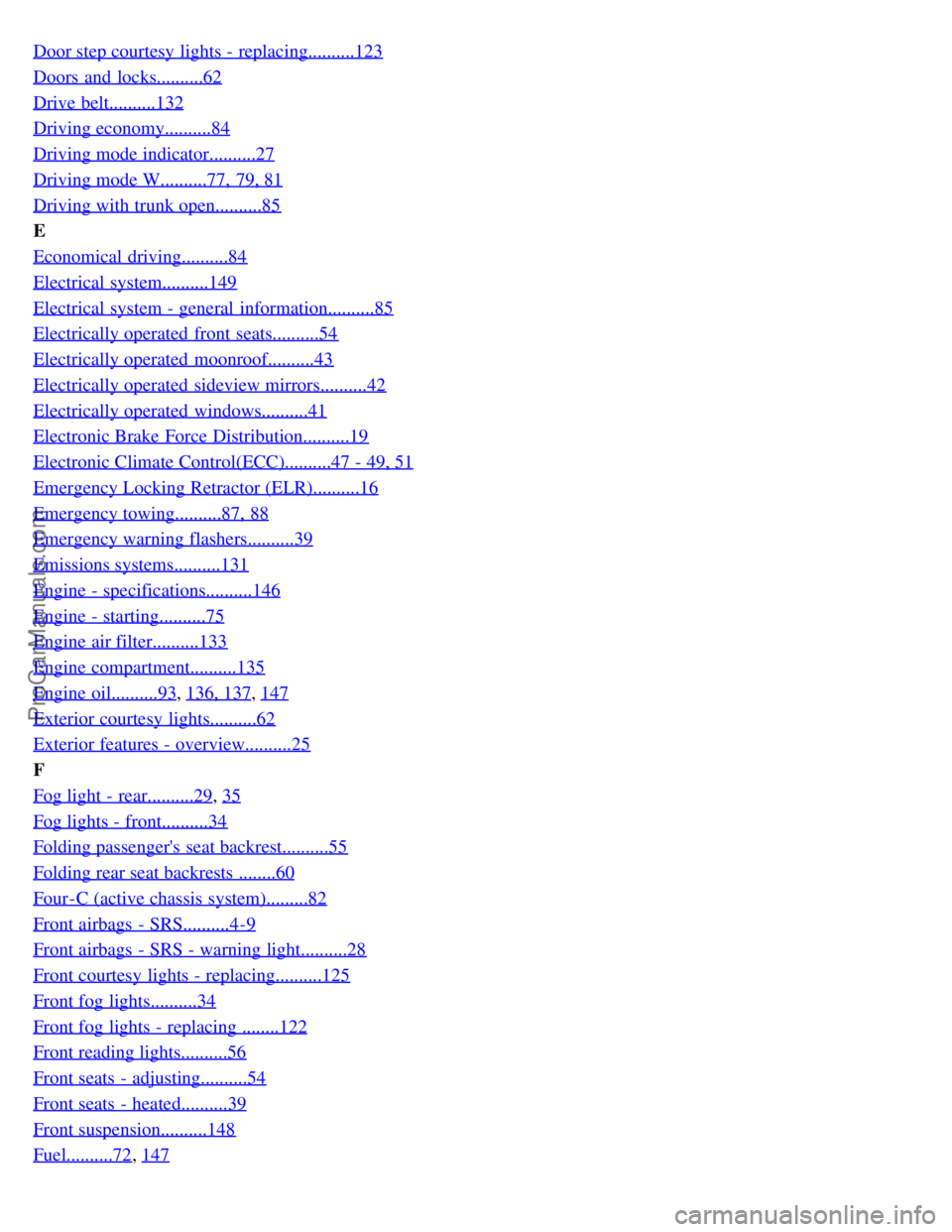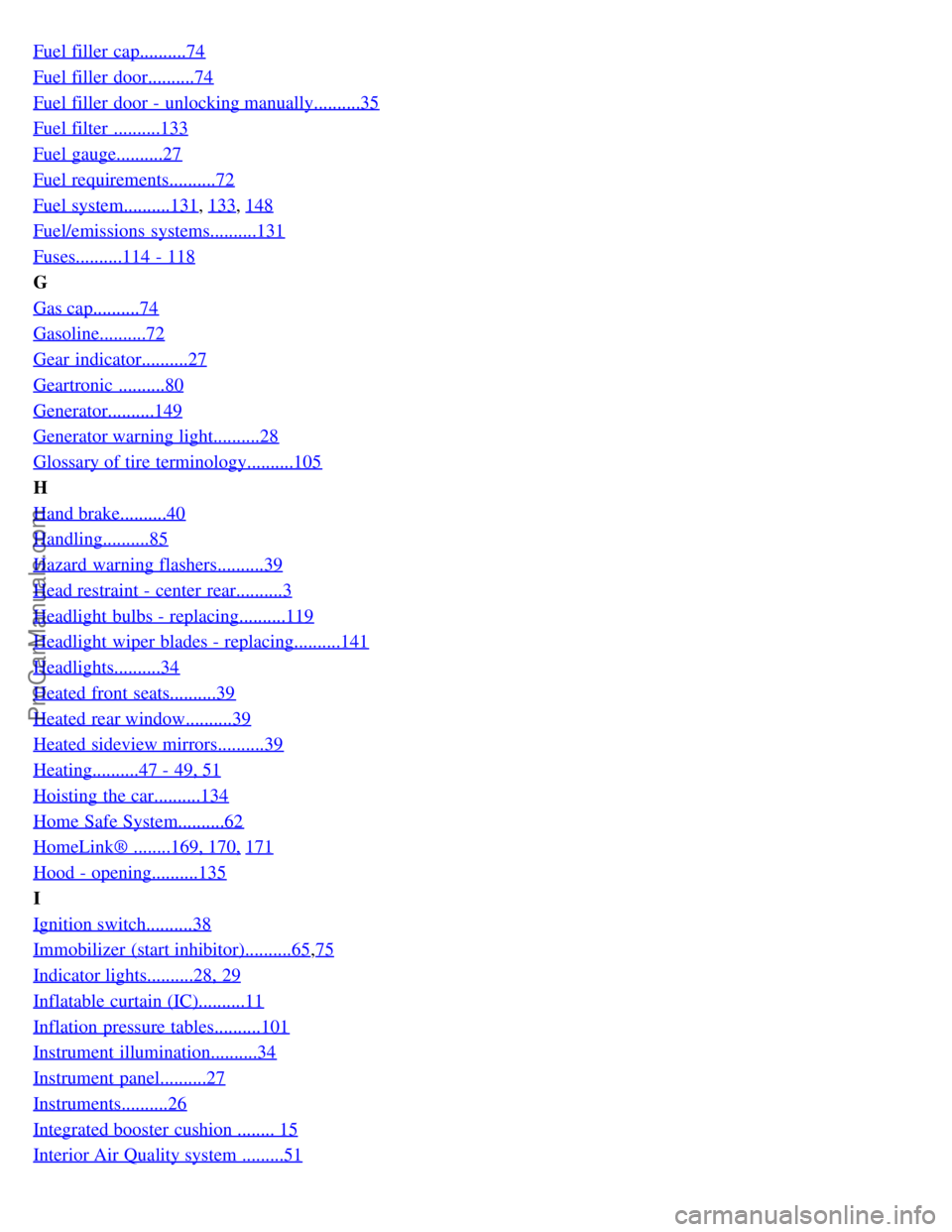2005 VOLVO S80 air filter
[x] Cancel search: air filterPage 28 of 123

Press the switch to turn the air conditioning on or off. The "ON" or "OFF" LED will light up to indicate if the system
is switched on or off. Other functions will still be regulated automatically (if the AUTO switch is on).
The air conditioning functions only at temperatures above 32° F (0° C).
While the Defroster function is selected, the air conditioning is temporarily activated to dehumidify the air, even if
you have manually switched the air conditioning off. This will only function if the blower is not switched off.
Blower control
Turn the control clockwise to increase or counterclockwise to decrease the blower speed. Pressing the AUTO switch
will automatically regulate blower speed and override manual adjustment.
NOTE: Turning the blower control counterclockwise as far as possible (an orange LED next to the control will light
up) will turn both the blower and the air conditioning off.
pg. 50 Climate control system - general information
Condensation on the inside of the windows
Keeping the insides of the windows clean will help reduce the amount of condensation that forms on the windows. Use
a commercial window cleaning agent to clean the windows.
Ice and snow
Always keep the air intake grille at the base of the windshield free of snow.
Cabin air filter
Replace the cabin air filter with a new one at the recommended intervals. Please refer to your Warranty and Service
Records Information booklet, or consult your Volvo retailer for these intervals. The filter should be replaced more
often when driving under dirty and dusty conditions. The filter cannot be cleaned and therefore should always be
replaced with a new one.
Sensors
The sunlight sensor on the dashboard and passenger compartment temperature sensor in the ECC control panel should
not be covered in any way as this could cause incorrect information to be sent to the ECC system.
Parking the car in warm weather
If your car has been parked in the sun in warm weather, opening the windows and sun roof (option) for several
minutes before driving will help release the warm air from the passenger compartment. When the engine is running,
close the windows and sun roof and use the recirculation function for several minutes to enable the air conditioning to
cool the compartment as quickly as possible.
Windows and optional moonroof
The ECC system will function best if the windows and optional moonroof are closed. If you drive with the moonroof
open, we recommend that you manually adjust the temperature and blower control (the LED in the AUTO switch
should be off).
Acceleration
The air conditioning is momentarily disengaged during full-throttle acceleration.
ECC maintenance
All maintenance on the climate control systems should be carried out by an authorized Volvo service technician only.
Refrigerant
ProCarManuals.com
Page 29 of 123

Volvo cares about the environment. The air conditioning system in your car contains a CFC-free refrigerant - R134a
(HFC134a). This substance will not deplete the ozone layer. The system contains 2.2 lbs (1000 g) R134a and uses
PAG oil.
Passenger compartment blower
Approximately 50 minutes after the ignition is turned off, the blower may come on automatically, and run for five
minutes, to remove condensation in the A/C evaporator.
pg. 51 Electronic Climate Control (ECC) - with Interior Air Quality system (option)
Interior Air Quality system (option)
Some cars are equipped with a multifilter and air quality sensor. The filter separates gases and particles, thereby
reducing the amounts of odors and contaminants entering the car. The air quality sensor detects increased levels of
contaminants in the outside air. When the air quality sensor detects contaminated outside air, the air intake closes and
the air inside the passenger compartment is recirculated, i.e. no outside air enters the car. The filter also cleans
recirculated passenger compartment air. When the Air quality sensor is activated, the LED AUT comes on in the
recirculation button
Operation:
Press
to activate the Air quality sensor (normal setting).
Or select one of three functions by pressing
1. Press
the LED AUT comes on.
The Air quality sensor is now activated.
2. Press
no LED is lighted.
Recirculation not activated.
3. Press
the LED MAN comes on. Recirculation is now activated. You can switch between these three functions
by repeatedly pressing
Keep the following in mind:
Make it a rule to have the air quality sensor activated at all times.
Recirculation is limited in cold climates to avoid misting up.
If misting occurs, you should deactivate the Air quality sensor.
If the windows mist up, you can also use the windshield and side window defroster functions. See page 48.
The filter should be changed at the intervals listed in the Warranty and Service Records Information booklet.
However, if the car is used in a severely contaminated environment, it may be necessary to change the filter more
frequently.
pg. 52
This page intentionally left blank.
ProCarManuals.com
Page 62 of 123

· Press the Park assist button on the center console (see page 31) to temporarily deactivate the system(s).
· The indicator light in the button will go out when the system(s) have been deactivated.
· If the vehicle is equipped with front and rear park assist, both systems will be deactivated by pressing the button.
NOTE:
It may be necessary to deactivate one or both of the park assist systems in certain cases.
· Rear park assist: towing a trailer, carrying bicycles in a rear-mounted carrier, etc, could trigger the rear park assist
system's sensors.
· Front park assist: it may not be possible to combine auxiliary headlights and front park assist since these lights
could trigger the system's sensors.
Faults in the system
If a fault should occur in the system, the LED in the button will be switched off and a message will be displayed in the
text window.
Cleaning the sensors
For the system to function properly, the sensors in the front and/or rear bumpers should be kept clean. They can be
cleaned with car washing detergent and a sponge.
WARNING!
These systems are designed to be a supplementary aid when parking the vehicle. They are not, however, intended to
replace the driver's attention and judgement.
pg. 84 Driving economy
Economical driving conserves natural resources
Better driving economy may be obtained by thinking ahead, avoiding rapid starts and stops and adjusting the speed of
your vehicle to immediate traffic conditions. Observe the following rules:
Bring the engine to normal operating temperature as soon as possible by driving with a light foot on the accelerator
pedal for the first few minutes of operation. A cold engine uses more fuel and is subject to increased wear.
Whenever possible, avoid using the car for driving short distances. This does not allow the engine to reach normal
operating temperature.
Drive carefully and avoid rapid acceleration and hard braking.
Do not exceed posted speed limits.
Avoid carrying unnecessary items (extra load) in the car.
Maintain correct tire pressure. Check tire pressure regularly (when tires are cold).
Remove snow tires when threat of snow or ice has ended.
Note that roof racks, ski racks, etc., increase air resistance and also fuel consumption.
Avoid using automatic transmission kickdown feature unless necessary.
Avoid using the air conditioning when it is not required. When engaged, the A/C compressor places an additional
load on the engine. However, at higher driving speeds, fuel consumption will be lower with the air conditioning on and
the windows closed than with the air conditioning off and the windows open.
Using the onboard trip computer's fuel consumption modes can help you learn how to drive more economically.
Other factors that decrease gas mileage are:
Dirty air cleaner
Dirty engine oil and clogged oil filter
Dragging brakes
Incorrect front end alignment
Some of the above mentioned items and others are checked at the standard Maintenance Service intervals.
ProCarManuals.com
Page 95 of 123

Number of valves24
Charge air cooler (Intercooler)
Turbocharged engines employ a turbo-compressor to force air into the engine inlet manifold and a charge air cooler to
cool the compressed inlet air. The resulting increase in air flow raises pressure in the intake manifold and increases
engine power over that developed by the normally-aspirated engine. The charge air cooler (which resembles a radiator)
is located between the turbo-compressor and inlet manifold.
Designation: Volvo B 5254 T2
Output 208 hp at 5000 rpm (154 kW/83 rps)
Max. torque 236 ft. lbs. at 1500-4500 rpm (320 Nm/25-75 rps)
Number of cylinders 5
Bore 3.27" (83 mm)
Stroke 3.67" (93.2 mm)
Displacement 2.5 liters
Compression ratio 9.0:1
Number of valves 20
All specifications are subject to change without prior notice.
pg. 147 Oil/fluid specifications and volumes
Engine oil
Meeting minimum ILSAC specification GF-2, including ACEA A1, API SJ, SJ/CF and SJ/Energy Conserving.
Extra oil additives must not be used.
Volume: (including filter):
5-cylinder turbo engine - 6.1 US qts (5.8 liters).
6-cylinder engines - 6.9 US qts (6.6 liters).
Automatic transmission fluid
Total volume: 7.6 US qts (7.2 liters).
Type: JWS 3309
Different types of oil should never be mixed.
Cooling system
Type: Positive pressure, closed system. The thermostat begins to open at 194 °F (90 °C).
Coolant: Volvo original coolant/antifreeze.
Volume: 9.5 US qts (9.0 liters)
Power steering fluid
Volvo synthetic power steering fluid (Pentosin CHF 11S) P/N 1161529 or equivalent.
Volume: 0.95 US qt (0.9 liter).
Brake fluid
DOT 4+ boiling point > 536°F (280° C) P/N 9437433
Volume: 0.6 US qt (0.6 liter)
Climate control system - refrigerant (R 134a)
Oil: PAG
Volume: 2.2 lbs (1000 g) R134a.
ProCarManuals.com
Page 112 of 123

2 0 0 5
VOLVO S80
Index
pg. 173 Index
A
ABS..........19
ABS - warning light..........29
Active chassis system (Four-C)..........82
Adjusting the steering wheel..........38
Air conditioning..........47- 49, 51
Air filter - engine..........133
Air vents..........46
Airbag (SIPS)..........10
Airbag (SRS)..........4
Alarm..........67, 68
Alarm - "panic" function..........67
All Wheel Drive (AWD) general information..........96
ALR/ELR..........16
Anti-lock Brake System (ABS)..........19
Anti-lock Brake System - warning light..........29
Antifreeze..........93, 132
Approach lighting..........62
Ashtrays..........40
Audio systems..........151
CD player..........163
HU -650 - overview..........153
HU -850 - overview..........154
specifications..........168
Automatic car washing..........128
Automatic Locking Retractor (ALR)..........16
Automatic transmission
five speed..........78
four speed..........76
Geartronic..........80
Auxiliary socket..........40
ProCarManuals.com
Page 114 of 123

Door step courtesy lights - replacing..........123
Doors and locks..........62
Drive belt..........132
Driving economy..........84
Driving mode indicator..........27
Driving mode W..........77, 79, 81
Driving with trunk open..........85
E
Economical driving..........84
Electrical system..........149
Electrical system - general information..........85
Electrically operated front seats..........54
Electrically operated moonroof..........43
Electrically operated sideview mirrors..........42
Electrically operated windows..........41
Electronic Brake Force Distribution..........19
Electronic Climate Control(ECC)..........47 - 49, 51
Emergency Locking Retractor (ELR)..........16
Emergency towing..........87, 88
Emergency warning flashers..........39
Emissions systems..........131
Engine - specifications..........146
Engine - starting..........75
Engine air filter..........133
Engine compartment..........135
Engine oil..........93, 136, 137, 147
Exterior courtesy lights..........62
Exterior features - overview..........25
F
Fog light - rear..........29
, 35
Fog lights - front..........34
Folding passenger's seat backrest..........55
Folding rear seat backrests ........60
Four-C (active chassis system).........82
Front airbags - SRS..........4-9
Front airbags - SRS - warning light..........28
Front courtesy lights - replacing..........125
Front fog lights..........34
Front fog lights - replacing ........122
Front reading lights..........56
Front seats - adjusting..........54
Front seats - heated..........39
Front suspension..........148
Fuel..........72, 147
ProCarManuals.com
Page 115 of 123

Fuel filler cap..........74
Fuel filler door..........74
Fuel filler door - unlocking manually..........35
Fuel filter ..........133
Fuel gauge..........27
Fuel requirements..........72
Fuel system..........131, 133, 148
Fuel/emissions systems..........131
Fuses..........114 - 118
G
Gas cap..........74
Gasoline..........72
Gear indicator..........27
Geartronic ..........80
Generator..........149
Generator warning light..........28
Glossary of tire terminology..........105
H
Hand brake..........40
Handling..........85
Hazard warning flashers..........39
Head restraint - center rear..........3
Headlight bulbs - replacing..........119
Headlight wiper blades - replacing..........141
Headlights..........34
Heated front seats..........39
Heated rear window..........39
Heated sideview mirrors..........39
Heating..........47 - 49, 51
Hoisting the car..........134
Home Safe System..........62
HomeLink® ........169, 170, 171
Hood - opening..........135
I
Ignition switch..........38
Immobilizer (start inhibitor)..........65,75
Indicator lights..........28, 29
Inflatable curtain (IC)..........11
Inflation pressure tables..........101
Instrument illumination..........34
Instrument panel..........27
Instruments..........26
Integrated booster cushion ........ 15
Interior Air Quality system .........51
ProCarManuals.com